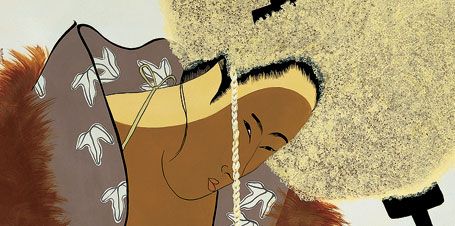
a3 blackface #59, 2003
Acrylic on paper
50 x 38 inches
Museum purchase, with funds contributed by Dr. and Mrs. Lindley T. Smith, 2004.6
Back in 1997, I read an article written by Joe Wood that introduced me to a group of Japanese youth called ganguro, who darkened their skin and paid top dollar to have their hair permed into afros. I was fascinated by the idea and decided that one way for me to talk about the ganguro would be with the help of Japanese woodblock prints from the Edo period. Ukiyo-e, the floating world, was a time of decadence. There are parallels between the glamorous, fashionable clothes and other excesses portrayed in ukiyo-e and the high fashion, celebration of material success and love of bling-bling that you get in hip-hop. Being African-American, I’m flattered that our music and style is so influential, but I have to say that I find the ganguro obsession with blackness pretty weird, and a little offensive. My paintings come out of trying to make sense of this appropriation.
Part of the romantic idea is that we are all mirror images of each other. Beyond the ganguro phenomenon, there are many connections between those two cultures: on a good day, the relationship is reciprocal, the dark-faced ganguro may not be popular anymore, but the acquisition of hip-hop accoutrements, both visual and verbal, is vogue, fly, fresh. Hip-hop music can be woven together quite beautifully and poetically. It’s an attempt to connect and be heard and respected all over the world. But people talk the most about the material aspects of it. I hate the whole consumer vibe of mainstream hip-hop. The potential for the music gets compromised and the music and the message get lost. A better understanding of a culture gets lost in all this.
I RE-present these prints to represent the present while maintaining connections with the past. Hip-hop, and therefore, black culture, should do the same thing.
